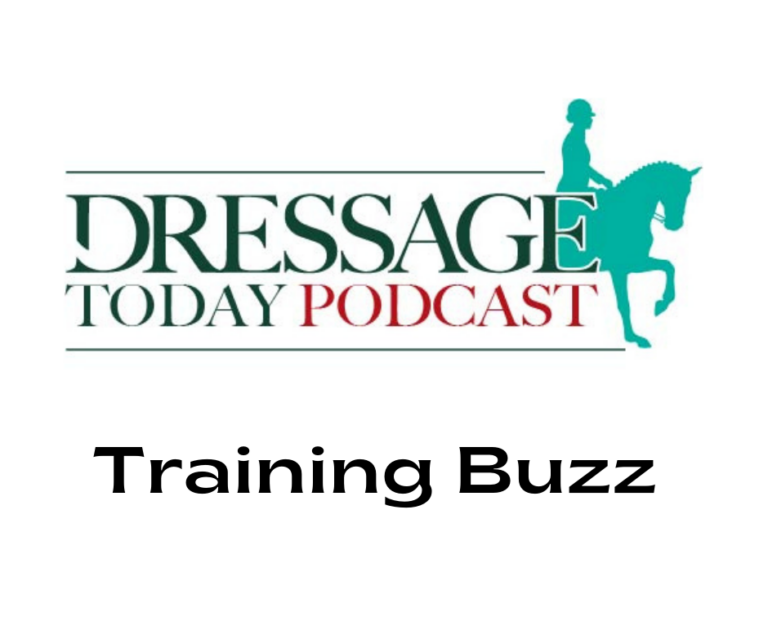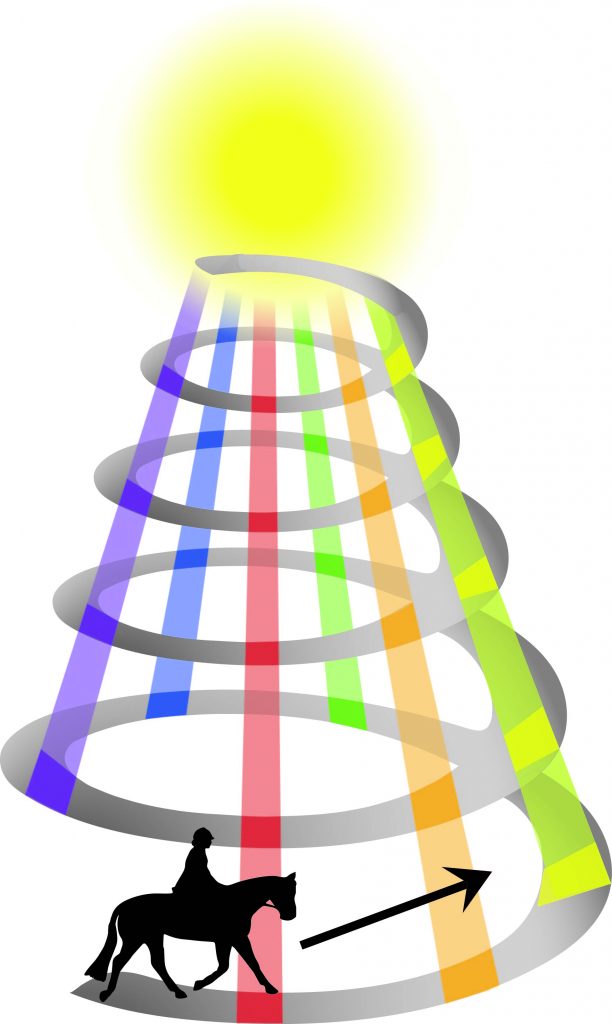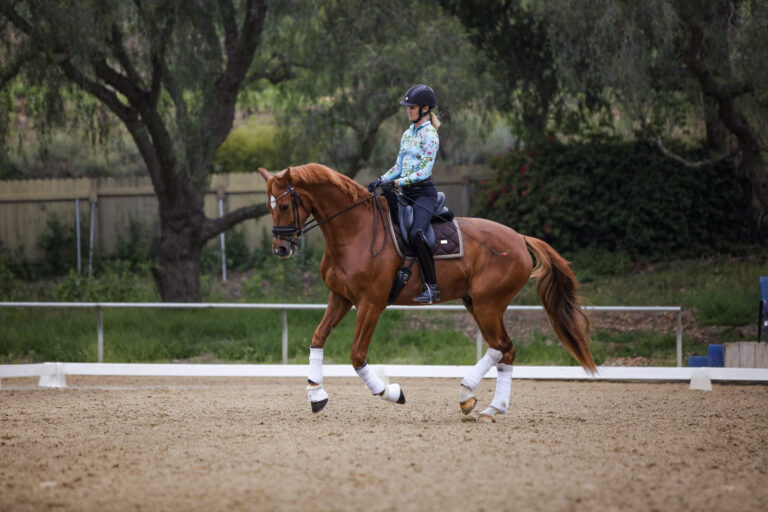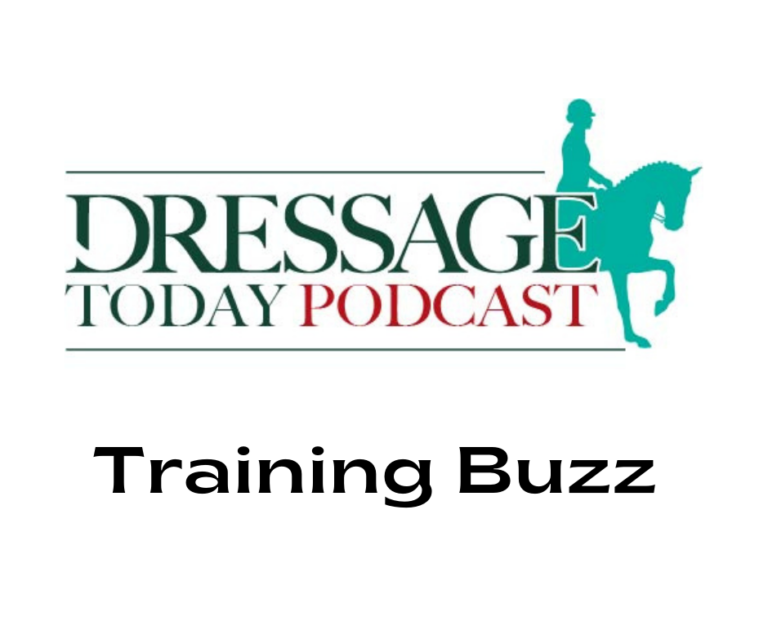In your dressage journey, no doubt you will encounter challenges in your training. Your horse might be having problems with a particular exercise. For example, when asked to lengthen the trot, perhaps his stride becomes faster rather than longer. Or maybe he consistently picks up the wrong lead. For these problems and others, the diagnostic solution lies in the practical use of the Pyramid of Training. The Pyramid is made up of six concepts—rhythm, relaxation, connection, impulsion, straightness and collection. First, I’ll explain what the Pyramid is, and then I will give you some ideas on how to use it to help solve problems.
The original “Training Scale” was developed by the German military to ensure that classical principles and traditions were honored and adhered to by each generation of riders. It is often depicted in a pyramid shape with rhythm as the foundation step and collection at the top. A committee made up of members of the U.S. Dressage Federation (USDF) “L” Education faculty and Instructor Certification faculty examiners developed the present Pyramid of Training that clarifies the terms while keeping the order and spirit of the original training scale.
Dressage judges use the Pyramid of Training when evaluating the basics demonstrated in dressage tests. Experienced riders use it to make their rides more productive. Successful trainers use it to develop their horses in a harmonious and logical manner. All use it to solve problems. It is worth the effort to make the Pyramid of Training a part of your thinking, because it will save you a lot of time and frustration.
Each concept in the Pyramid of Training is an essential ingredient in the correct training of the horse. It is important to remember that there is a logical order of the steps, but the concepts are very much interrelated. One step does not have to be perfected before starting the next, but they build upon one another. That is, as you move up the Pyramid, the qualities of the lower elements will improve if you are on the right track with the schooling of your horse. For example, as the horse becomes more collected, with impulsion and straightness, the quality of his rhythm will improve and become more cadenced. If there is a problem with the rhythm, such as a lateral walk or a four-beat canter, there is a problem with the basic training.
An alert, successful rider or trainer will ask herself many questions pertaining to the Pyramid of Training. For example, when her horse begins to exhibit a four-beat canter, she will ask if it is because he is tense or lacking relaxation, not accepting the connection or lacking impulsion?
Addressing the source of the problem at its root leads to harmonious schooling of the horse.
The Purpose of the Tests
The concepts of the Pyramid are embodied in the Purposes of the dressage tests. You can find the Purpose at the top of each test. According to the U.S. Equestrian Federation (USEF), the Purpose of the Training Level test is to “confirm that the horse’s muscles are supple and loose and that [the horse] moves freely forward in a clear and steady rhythm, accepting contact with the bit.” That statement covers the first three elements in the Pyramid of Training. A correctly
trained and ridden Training Level horse will successfully exhibit rhythm, relaxation and connection according to the expectations of the tests.
Rhythm
When the Purpose of the test refers to a horse that “moves freely forward in a clear and steady rhythm,” it is referring to the rhythm found in the Pyramid of Training. According to the USDF definition, “rhythm is the term used for the characteristic sequence of footfalls and timing of a pure walk, pure trot and pure canter. The rhythm should be expressed with energy and in a suitable and consistent tempo with the horse remaining in balance and self-carriage appropriate to [his] level of training.”
It is fundamental to the philosophy of dressage that the gaits of the horse be preserved. As the training progresses, the quality of the gaits should improve so they become more elastic and have more scope and range of motion, while keeping the purity of the rhythm. When the rider or trainer feels or observes a pervasive loss of rhythm in certain movements—leg yield, shoulder-in or half pass—it should raise a red flag. The problem can be solved more efficiently if it is addressed at the cause rather than the symptom. Often the irregularity in a movement is caused by a lack of the necessary prerequisites for that particular movement. These prerequisites are found in the other elements of the Pyramid of Training: relaxation, connection, impulsion, straightness and collection.
The walk is said to be pure when the footfalls demonstrate regularity. The time between each beat and the length of each step should be the same. The walk has four beats: left hind, left front, right hind and right front. One of the most common problems is a lateral walk. When a rider is too strong with the hands or tries to collect the walk too soon, it causes the horse to hold his back rigidly, and the two legs on the same side almost step together.
The pure trot has a two-beat rhythm in which the alternate diagonal legs (left front and right hind and vice versa) are separated by an aerial phase (moment of suspension) in which all the legs are off the ground. It is important that the diagonal front and back legs remain parallel to one another. If not, it is an indication that the horse needs to be gymnasticized to develop his hindquarters so he is able to correctly do what is asked of him.
The pure canter is a three-beat gait with a moment of suspension. The footfalls for the left lead canter are: right hind, left hind and right front together, leading left front and a moment of suspension. When the diagonal pair becomes disunited, the canter is said to be four-beat. The main cause of a four-beat canter in which the front leg of the diagonal pair lands on the ground first, is that the rider attempts to collect the horse too much without creating enough energy from the hindquarters.
The best method of maintaining and improving the basic rhythm is to ride the horse with enough energy that he develops his muscles but doesn’t go so quickly that he tightens his back. The rider can recognize that her horse is at the appropriate tempo when he is neither sluggish nor too fast. When the horse is sluggish, he will not bend his joints and will often drag his feet. When he is too fast for his level of balance, he will pull more with his front legs and tighten his back making figures difficult because of lack of suppleness. It is often hard to sit the trot when the tempo is too fast.
Relaxation
Relaxation is the quality the Purpose of the test refers to when it states “that the horse’s muscles are supple and loose.” The USDF Pyramid of Training explains, “Relaxation refers to the horse’s mental state (calmness without anxiety or nervousness), as well as his physical state (the absence of negative muscular tension). Usually, the mental and physical states go hand-in-hand. The horse learns to accept the influence of the rider without becoming tense. He acquires positive muscle tone so that he moves with elasticity and a supple, swinging back, allowing the rider to bend him laterally as well as lengthen and shorten his frame.” Without relaxation it is impossible to teach the horse the more advanced exercises, because his mind will be defensive instead of receptive, and his body will not be able to take on increased demands. The horse may become unusually resistant and disobedient when he is asked to perform exercises and movements that he is not prepared to do.
Schooling exercises that help the horse to be calm, supple and relaxed are rising to the trot, large circles, serpentines, shallow loops, large figures-of-eight, turns on the forehand, leg yield and simple transitions, such as trot-canter-trot and trot-walk-trot. Longeing, cavalletti work and hill work are also helpful.
When the horse is supple and relaxed, his back will swing in a way that allows the rider to sit deeply with coordination. He will be able to bend on curved lines while maintaining his rhythm and tempo. The rider will be able to adjust the horse’s topline by giving and taking the reins without him speeding up or slowing down.
Connection
When the Purpose of the test states “accepting the contact with the bit,” it refers to the connection step in the Pyramid of Training defined as “acceptance of the bit through acceptance of the aids.” Further explanation states, “The energy generated in the hindquarters by the driving aids must flow through the whole horse and is received in the rider’s hands. The contact to the bit must be elastic and adjustable, creating fluent interaction between horse and rider with appropriate changes in the horse’s outline.”
A horse can only learn to accept a rider’s aids when he has the correct back-to-front connection. In this state, his mind and body can develop so that he will stay sound and enthusiastic within his work. Exercises that are helpful in the development of connection are transitions from one gait to another, such as walk-trot-walk and trot-canter-trot, and lengthening and shortening of the stride at the trot and canter.
These transitions can be done on straight lines to encourage more energy or on curved lines, where the bend and slight positioning of the horse to the inside is the first step in the development of the inside leg to outside rein connection. The thoughtful rider will develop combinations of figures to give the work variety and keep it interesting and healthy for the horse.
A test of connection is that the horse will chew the bit with a closed mouth by reaching forward and down when the rider releases the reins. This must be done in a manner in which the rider maintains a light contact. The horse will stretch over his back while maintaining his balance, rhythm and tempo.
Impulsion–Building Your Pyramid Upward at First Level
When your horse shows the above basics of rhythm, relaxation and connection, you will be able to perform a correct Training Level test, and you are ready to embark on a First Level test. The Purpose is “to confirm that the horse, in addition to the requirements of Training Level, has developed thrust (pushing power) and achieved a degree of balance and throughness.”
“Thrust” refers to impulsion, the fourth quality in the Pyramid of Training. Impulsion is described as “ the transmission of an eager and energetic yet controlled propulsive thrust generated from the hindquarters into the athletic movement of the horse. Impulsion is associated with a phase of suspension such as exists in trot and canter but not in walk.” Impulsion is necessary to develop the medium paces, because they demand that the horse be able to carry himself forward and be elastic, supple and engaged.
The First Level tests require that a horse have the ability to lengthen his strides, first at trot and then at the canter. These are the foundation exercises working toward medium and later in the training, with additional collection, the extended version of the gaits. When first schooling the trot and canter lengthenings, it is a good idea to only lengthen as many strides as your horse can stay balanced. This may be just five to eight strides before asking him to come back to the working pace. The transitions are gymnastic and build his strength to do the further work.
The thrust at First Level is also known as “pushing power.” With additional impulsion and straightness, “carrying power” develops. The joints in the horse’s hindquarters become more flexible, and the muscles gain strength. When your horse can change his length of stride smoothly with power and articulation of his hindquarters, you will know that you are improving his impulsion. As impulsion is developed correctly, the horse relies less and less on the reins for balance, and he is able to demonstrate self-carriage. The swinging back and active hindquarters enable the rider to sit with a deep, harmonious seat.
Straightness—Second Level and Above
The Second Level tests require “a greater degree of straightness, bending suppleness, throughness, balance and self-carriage.” Straightness is “improved alignment and balance. A horse is said to be straight when the footfalls of the forehand and the hindquarters are appropriately aligned on straight and curved lines and when his longitudinal axis is in line with the straight or curved track on which he is ridden. By nature, every horse is crooked—hollow on one side and stiff on his other side—thereby using one side of his body somewhat differently from the other.” It is only possible to correctly collect a horse that is straight. The pushing and carrying capabilities of the horse can only be effective when the hind legs step evenly under his mass. The demands of the tests from Second Level to Grand Prix require that the horse have the ability to increasingly collect and lighten his forehand.
Most horses carry the right hind leg to the right of the body, forcing them to put more weight on the left shoulder. This can be observed, as he will step with his left hind foot toward his midline while the right hind will step to the right side of his body. The rider will feel more weight in her left rein, because the horse is loading that shoulder and tensing the muscles on that side of his neck. The right side is the hollow side, because the horse does not take the contact on that side.
The gymnastic exercises with bend help to straighten a horse. A crooked horse is not evenly supple left and right, so riding him on circles, serpentines, corners and changes through the circle are appropriate figures to work out the stiffness. Take special care to ride the horse on precise lines. Otherwise, he will continue to be crooked, because he will take the track that is the easiest for him. As he advances in his training, leg yields and, later on, shoulder-in will be useful exercises in the straightening process. The horse is straight when the rider feels an even contact on both reins, finds it easy to make the aforementioned figures, is able to sit squarely and notices that the horse’s ears are level.
Collection—the Pinnacle
The quality of collection is first addressed in the Purpose of the Second Level tests when it states that the horse “shows that through additional training [he] accepts more weight on the hindquarters (collection), shows the uphill tendency required at the medium gaits and is “reliably on the bit.” Collection is described in the Pyramid of Training as “increased
engagement, lightness of the forehand, self-carriage.” Further explanation states, “The horse shows collection when he lowers and engages his hindquarters, shortening and narrowing his base of support, resulting in lightness and mobility of the forehand. Because the center of mass is shifted backward, the forehand is lightened and elevated [and] the horse feels more “uphill.” [His] neck is raised and arched, and the whole topline is stretched. He shows shorter yet powerful cadenced steps and strides.”
The elevation of the forehand is a result of, and relative to, the lowering of the hindquarters. This is known as “relative elevation.” When only the neck is raised without the corresponding displacement of the center of mass to the rear, it can eventually create unsoundness. This forced, short neck with hind legs out is known as “absolute elevation.” Exercises that improve the collection, if done while keeping the purity of the rhythm, suppleness of the back and impulsion, are: trot-halt-trot transitions, canter-walk-canter transitions, shoulder-in, travers, renvers and half-pass, turns on haunches and pirouettes at the walk. Indications that the collection is progressing in the right way are: the horse can be ridden more and more on the seat; the shoulders of the horse are more mobile; the movements become easier to perform; the rider’s leg and hand aids can become lighter; the ride is pleasurable for both horse and rider.
When a horse is successfully schooled through the logical, theoretical basis using the Pyramid of Training as a guide, he is said to have throughness. This means that he is supple and elastic with an unblocked connection that allows the aids to go through the whole horse both mentally and physically. There is a flow of energy that originates from the active hindquarters to the rider’s hand and back to hindquarters again. This is called the “circle of the aids.” The result is that the rhythm remains pure, and the horse is supple in his joints; he reaches for the bit, has lively impulsion and has acquired the degree of balance appropriate
for his level of training.
As you become familiar with using the pyramid of training to solve your training challenges, you are going to enjoy a clear system that makes your schooling sessions more positive for both you and your horse.
Maryal Barnett is an FEI (Fédération Équestre Internationale) “C,” a USEF “S” and an Equine Canada Senior dressage judge. An examiner for the USDF Instructor Certification program, she
is also a silver and bronze medalist. She trains horses and teaches riders to Grand Prix out of Nottingham Equestrian Center in East Lansing, Michigan.
Definitions from the USDF Glossary of Judging
Terms have been reprinted with permission. Portions of “Purposes” from the 2007 USEF dressage tests have been reprinted with permission. ©2006
by United States Equestrian Federation® All Rights reserved. Reproduction without permission is prohibited
by law. USEF is not responsible for any errors
or omissions in the publication or for the use of its
copyrighted materials in any unauthorized manner.











